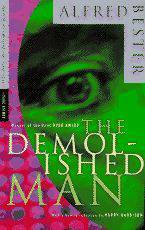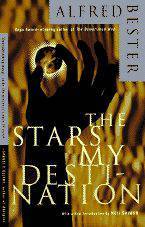

| Click on a book's image or title to order from Amazon.com |

The Demolished Man
Vintage Books, PB, © 1950, 243 pp, ISBN #0-679-76781-9Reviewed December 1996
I've wanted to read Bester's two classic SF novels for nearly a decade, but for some reason they've simply been Not Available, even used. Vintage books has recently reprinted them in nice oversized-paperback editions, and I made a point of picking them up.
What struck me first about The Demolished Man is that Bester's writing style doesn't feel like other SF I've read from the 1950s (much less the 40s). I don't think it's so much that he was ahead of his time in the field, as that he was outside of it altogether; although the future-metropolitan feel of the narrative echoes, say, William Gibson's work, this novel clearly isn't a product of the 80s.
The main aspect of Bester's writing style that seems to link this book to the era in which it was published is that his approach to plotting is one of "Let's dispense with the formalities and get down to business". The Demolished Man plows forward at a frenetic pace, with only a few quiet interludes to break up the action. One result of this is that most of the characters possess less texture and depth than one might expect from the better modern novels.
The Demolished Man is science fiction in the grand style: It takes place in a future New York which is patrolled by the Esper Guild - a strict organization of the world's telepaths (the Psi Corps in Babylon 5 was largely based on the Guild). Members of the Guild easily pick up stray thoughts and thoughts from unguarded minds, and thereby keep the peace by detecting when a person is contemplating committing a crime. Hence, New York hasn't had a murder case in decades when the story begins.
Ben Reich is the head of Monarch, one of the most powerful corporations in the solar system. However, the rival D'Courtney corporation is threatening to defeat Monarch in the long-term marketplace battle. Reich sends a coded message to Craye D'Courtney offering a merger. When he is refused, he determines to do the impossible, and murder D'Courtney. The remainder of the novel focus on Reich's murder effort - complicated by the presence of D'Courtney's daughter as a witness, who escapes into the city - and Reich's effort to avoid conviction. He's aided in that telepathic evidence is not permitted at trial, although since telepaths can detect the efforts made to cover up the physical evidence, it's still very hard to get away with. Reich's opposition in his campaign is the Police Prefect, Lincoln Powell, a first-grade telepath.
The Demolished Man works out in great detail Reich's plans and counter-plans, and the driving pace of the novel makes it easy to forgive a few small implausibilities, such as Reich's use of an infectious popular song running over and over in his head to make his mind hard to read (I didn't quite buy this, personally). Moreover, the novel's pace results in the portrayal both Reich and Powell as men of instant, decisive action (indeed, Reich's "killer instinct" is alluded to on more than one occasion), and thereby figures of almost mythic proportions.
The concluding chapters of the novel turn into a sort of psychodrama involving Reich's motivations for his deed, and the muddled facts of the case. The climactic scene is an intricate dream sequence in which Powell makes Reich realize what's really happening; this sequence put me off a little, since I tend to see such sequences as an excuse for the author to employ some literary pyrotechnics without having to try to hang them on a really substantial plot. In other words, I think the sequence was needlessly flamboyant.
But the final chapter presents an interesting perspective about the value of an individual to society, and that a man prepared to risk all to defy society's rules shouldn't simply be executed (as the term "demolition" implied was the punishment Reich would meet if he failed to cover his tracks), but should be retrained with Esper assistance to put his skills and drive to society's benefit.
A very good novel, and one that stands up very well in the 1990s, I think.

The Stars My Destination
Vintage Books, PB, © 1956, 258 pp, ISBN #0-679-76780-0Reviewed December 1996
I agree with Neil Gaiman in his introduction: The original title for this novel - Tiger! Tiger! - is much more apropos, for The Stars My Destination is far more concerned with the nature of the human predator than with any effort to escape the bounds of the Solar System; indeed, this point is really only tacked on at the very end.
Although Bester's writing style had evolved appreciably from The Demolished Man to Stars, I don't think this novel is nearly as successful as its predecessor. For one thing, it starts out with a protracted exposition on the nature of 'Jaunting' - the natural teleporting ability that humans have and which has been discovered and harnessed by the time Stars begins. (One presumes that the Jaunting ability of the teens in the SF series The Tomorrow People came from this.)
Additionally, Bester seems intent on pulling every notional rabbit out of his intellectual hat that he can, and thereby packs the novel which ephemera that often have little concrete bearing on the novel. For instance, the telepath who can send but not receive; the man who is perpetually radioactive; and even the war between the inner planets and the Outer Satellites of the solar system. All of these elements lend some background color to the novel, but all are interesting ideas in and of themselves and hence tended to make the novel a little too dense for my taste.
But the basic plot is fundamentally sound: Gully Foyle, a man with no skills or talents, is marooned aboard the decimated spaceship Nomad, its only survivor. The spaceship Vorga pulls alongside and is signalled by Foyle, but chooses not to rescue him. Foyle therefore determines to pay Vorga back in kind, to destroy it. Amazingly, he manages to repair the ship enough to return to civilization (pretty neat for a guy with no skills or talents). Along the way, it turns out that Foyle is in fact something of a genius, as he learns quickly and climbs up the social ladder in the space of just a couple of years in the pursuit of his goal.
Thus, The Stars My Destination begins as a study in psychopathic revenge, and of the more complicated forms it takes as Foyle becomes ever-more-sophisticated, first swearing revenge on a ship (he tries to bomb it), then on the people within that ship who made the actual decision to leave him behind, and finally he finds that he's in love with the woman who was ultimately behind the decision. And even after that, that he has skills and knowledge which make him more valuable to the world than as merely a man on a mission of revenge. In a sense, it heralds Daniel Keyes' Flowers for Algernon in its study of a rapidly evolving protagonist (albeit from a decidedly more brutal perspective).
Thematically, then, the novel is arresting. On a more mechanical level, it's less successful. As with Foyle's salvaging of Vorga, the maddening rate at which Foyle evolves is hard to believe, and his sudden transformation in the second half from little more than a street thug into a erudite and crafty aristocrat is shocking, at best. And, as in The Demolished Man, Stars ends with something akin to a dream sequence, only without the down-to-earth denouement of the earlier novel. Stars seems to fly out into space, ending with a somewhat-forced rebirth allegory.
Although I certainly admired and enjoyed much of the ride Bester carried me on through the novel's pages, I found in the end that although there was much to appreciate about The Stars My Destination, there was also a lot I didn't care for.
hits since 13 August 2000.